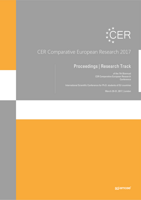CER2017

WEBEROVÁ, Veronika. 2017. Incorporation of painting techniques through the methods of artistic-creative communication in teaching practice. In Zborník konferencie CER Comparative European Research. International Scientific Conference for Ph.D. students of EU countries 2017. London: Sciemcee Publishing, 2017. s. 131-134. ISBN 978-0-9935191-4-7
INCORPORATION OF PAINTINTG TECHNIQUES THROUGH THE METHODS OF ARTISTIC-CREATIVE COMMUNICATION IN TEACHING PRACTICE
Veronika Weberová
Comenius University in Bratislava
Račianska 59
Bratislava, 813 34, Slovakia
On department +421 2 50222 100
vewe@weronikart.sk; weberova2@uniba.sk;
Abstract: Presentation of the results of research aimed at integrating painting techniques into the art of teaching experience with the use of method artistic-creative of communication. We describe the importance of artistic-creative communication in teaching practice. We focus on familiarizing students in adolescence with a wide variety of painting techniques and extend into the contexts of communication between teacher and students.
Keywords: artistic-creative communication, painting techniques, research, adolescent
1. Introduction
The project is a research-oriented quality. It is based on mapping the process of artistic-creative methods of communication such as the illustrative work with painting techniques. Artistic-creative communication is a method of teacher work with students simultaneously in one piece, leading to expressive and mostly the abstract artistic expression. It inspired the creation of Andy Warhol and Jean-Michael Basquiat in their common work. Artistic-creative communication gives us the opportunity to apply new painting techniques in teaching in an unusual way resting on the clearness and paves the way for better communication between teachers and pupils. This kind of creative communication takes place between pupils and teachers directly in the creation, turns on the establishment of a joint work as record specific dialogue in which participants alternated position with the position of the recipient creator of artwork.
2 Theoretical basis
In visual learning is the practical part of making important factor in fulfilling its objectives. "Because the only true art education: deed, creation itself." [9]. At the outset, we define painting techniques that we are able to move into the school environment. Emphasis was put on the intersections of classic and contemporary painting techniques, the overlap in playwriting and new paintings. "Technology in terms of the whole creative process is only a means of artistic expression."[3] Techniques were divided into two categories. Technology first category: Watercolor (transparent and opaque-gouache), Pastel (dry, oily, hard wax), Oil painting, Ebru, Acrylic, Encaustic and Digital painting. Techniques second category dealt with a set of techniques painting techniques under the first category, different techniques of oil painting, American, European and Cold technology of encaustic.
Selection criteria techniques were the research objectives: affordability, the possibility of incorporating into the art of teaching experience, the time required for the formation (one to two lessons), ease of procedure, the possibility of combining them, for experimentation with them, easy preparation. „An artist has a vast range of possibilities and must make decisions which depend on their knowledge, craftsmanship, judgement, opinion, vision, and many other aspects. In today's economic and technological context, painting (materials) is much more accessible than it used to be in previous centuries. The number of artists (creative people) has increased considerably just as did the variety of materials which can be used in art today." [10]
In addition to creating a list of painting techniques and their classification, we are focusing on their inclusion in school education, teacher´s personality as coordinator and subsequently artistic-creative communication, its objectives and the potential of the school setting.
Our work will focus mainly on the formation of young people in adolescence. Unlike pubescence, adolescence is a psychological category [6]. Adolescence usually takes place from 16 to 17 years to 21 years. [2] Turček [11] indicates end of adolescence at age 22, but Ondrejkovič [6] seen this age is seen as the end of the post adolescent period. Some authors reported adolescence up to 24 years. [1] [4]. Today we are witnessing a continuous tightening of the period. Distending the age of adolescence appears adulescencia term as first defined it in mid-1970 Tony Anatrella [1]. It constitutes a further phase transition teen to the adult world. Adulescencia takes place between 24 and 30 years of age (by Shaputis, it may take up to age 35). [7] This significant shift in the post-adolescent period is a result of stretching stages of personality development of young people and social development. Institutions aimed at educating young people should lead young people the transition from childhood to adult life. "Teacher and culture malleable human being ... rather allow, encourage, or facilitate or confirm to what exists in the bud, to become true." [5]
The above assumptions (theories) form the aims of artistic-creative communication and research to work with it. In education focus on personal development of the individual and his emotional maturation.
.................
4. Recommendations for practice
Artistic-creative method of communication can serve as a good resource for illustration for teaching painting techniques, or even building the image and abstract works. It also provides scope for improving communication between teacher and students and students with each other. The use of this space is the teacher and his communication skills.
The process of artistic-creative communication is quite structured and for various age groups may have different goals. We worked with him in the context of learning painting techniques. Research laid the foundation for further progress. Working with artistic-creative communication with other age groups, the non-specialist schools, more focus on the impact of personality development and teacher of painting in the style of independent creation by respondents work within the artistic-creative communication.
5. Conclusion
For acquiring skills in painting techniques in the process of artistic-creative communication it needs to teach pupils about activities to do, defined techniques, to name and to respond to their own experiments. Teacher in creating progressively implemented various painting techniques in a way that their other "forming" registered,
Artistic-creative dialogue may be an appropriate method for helping teachers to facilitate their vividly convey the students to work with painting techniques, disrupt formulaic visual learning process and establish effective communication with their pupils. It also showed that joint helps to create progress, teacher. Both sides in experimenting with the techniques in the process acquire a broader means of expression and perception of space abstract image as an internal record of the whole dialogue.
As a result of research we consider creation The Guide of painting techniques for school practice and creation, which was based on the progress and results of research. It maps the intersections of classic and contemporary painting techniques and adapting their categorization for artistic, educational practice. Painting techniques are selected on the basis of the procedures in research and the possibilities of their integration into the school setting.
References
[1] Anatrella, T., The adulescents. In Études, Volume 399, 2007/7 p. 37-47. ISSN 0014-1941 Available on: https://www.cairn.info/revue-etudes-2003-7-page-37.htm#no1
[2] Labáth, V. et al., Riziková mládež. Bratislava: SLON, 2001, 4 p. ISBN 80-85850-66-4
[3] Losos, Ľ., Techniky maľby. Bratislava: Pallas (SFVU), 1992, 8 p. ISBN 80-7095-014-5
[4] Luna, B. et al., Maturation of Cognitive Processes From Late Childhood to Adulthood. In PubMed, 2014. Volume 75, n. 5. (Sept.-Okt.) 1357-1372 p. Available on: https://www.researchgate.net/publication/8344332_Maturation_of_Cognitive_Processes_From_Late_Childhood_to_Adulthood
[5] Maslow, A. H., Ku psychológii bytia. Modra: Persona, 2000, 164 p. ISBN 80-967980-4-9
[6] Ondrejkovič, P., Socializácia mládeže ako východisková kategória sociológie výchovy a sociológia mládeže. Bratislava: Veda, 1997, 14 p. ISBN 80-224-0476-4
[7] Shaputis, K., The Crowded Nest Syndrome: Surviving the Return of Adult Children. WA?:Clutter Fairy Publishing, 2004. ISBN 978-0-9726727-0-2
[8] Silverman, D., Ako robiť kvalitatívny výskum. Bratislava: Ikar, 2005, 190 p. ISBN 80-551-0404-4
[9] Šalda, F. X., Boje o zítšek. Praha: Melantrich, 1948, 247 p.
[10] Šobáňová, P. et al., Useful symbiosis: sciene, technology, art&art education. Olomouc: Palacký University, 2016, 214 p. ISBN978-80-244-4853-4
[11] Turček, K., Psychopatologické a sociálno-patologické prejavy detí a mládeže. Bratislava: IRIS, 2003. ISBN 80-88778-99-9
